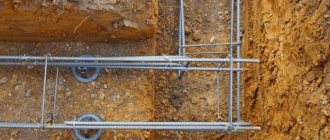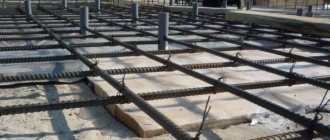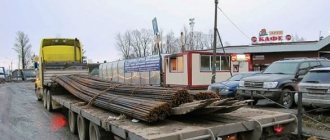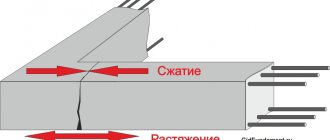The main requirement for concrete structures is strength and durability. To prevent the monolithic building from deforming during shrinkage, during the process of pouring the concrete solution, a special metal frame is installed - concrete reinforcement is performed. To create such an armored belt, steel rods are used, which are tied together with wire or welded. Welding reinforcement is considered the most reliable fastening, so let’s look at it in more detail.
Types of fittings welding according to GOST
According to the GOST 14098-91 standard, joining of reinforcement can be:
- electroslag semi-automatic;
- bath-suture;
- electric arc manual;
- contact;
- bathroom.
In this case, the welded joint itself can be:
- lap (for electric arc manual welding);
- butt;
- tee (resistance spot welding, which uses one electrode in the bath).
Let's take a closer look at the most common methods of welding reinforcement.
Basic reinforcement methods
Reliable connection of reinforcement is made using one of three methods:
- electric arc or contact welding;
- crimping of reinforcement bars;
- connection using tying wire.
Welding of reinforcement is performed in several ways, but has disadvantages. The main disadvantage is the disruption of the metal structure due to its heating and a decrease in strength at the weld site.
Such a joint does not work well in bending. If the seam is of poor quality, the joint may be damaged when the part is poured with concrete. Therefore, it is not recommended to use this method on soils with a high level of movement (quicksands, marshy areas).
It should be noted that when using the contact method and ready-made frames, welding can be used in such difficult conditions. The main advantage of welding reinforcement is speed and high level of productivity.
GOST 14098 recommends the use of reinforcing steels with index C. Products with this marking ensure high quality joints.
Overlap welding
This technology is most often used for reinforced frame elements that are not subject to increased loads. This means that such welding of reinforcement for the foundation is not suitable. The same applies to structures experiencing heavy bending loads. This type of connection is considered the most unreliable and least durable.
The principle of such joining of metal rods is to connect the rods in the longitudinal plane, with their ends offset by up to 30 cm from each other. The more overlap is made, the greater strength the welded structure will have.
Overlapping reinforcement welding is performed on both sides of the joint, which can cause inconvenience if one of the welds is on top and the other on bottom. In this case, it can be very difficult to reach the bottom seam.
Healthy! In order for the rods to fit together better, their ends must be cleaned with an iron brush and treated with abrasive tools so that the mating surfaces are flat.
Reinforcement frames must be welded in a certain mode, which will depend on the cross-section of the metal rods. Let's say you use products with a diameter of 5-8 mm. In this case, it is necessary to use electrodes with a cross section of 3 mm for welding. For 8-10 mm rods, you will need a 4 mm consumable. If the diameter of the rods is more than 10 mm, then electrodes with a diameter of 5 mm should be used.
Healthy! You can use any electrodes for overlap welding of reinforcement, but most often builders use ANO and MR consumables.
It is also necessary to take into account the current strength that will be required for rods of different diameters:
- for rods with a diameter of 5 mm, 200 A will be required;
- 6 mm – no more than 250 A;
- 8 mm – 300 A;
- 10 mm – 350 A;
- 20 mm – 450 A.
For more information about lap joints, watch the video:
Rules for selecting electrodes
For welding reinforcing bars, it is recommended to use electrodes of the brands E42, SM-11, ANO-5, ANO-6, VSC-4, UONI-13. Advantages - high quality of the weld, minimal consumption during welding, good temperature stability, no corrosion risk. Electrodes of these brands can operate at low ambient temperatures, which will be very useful in winter. To weld standard fittings with a diameter of 5-10 millimeters, electrodes with a diameter of 2-4 millimeters are used. For larger spare parts, electrode parts with a diameter of 4-6 millimeters are used.
Also, do not forget to check the strength of the welding current:
- To work with popular electrodes with a diameter of 3 mm of the E42 or SM-11 brand, it is better to use a current of 100 to 150 amperes. For thicker electrodes, the current must be increased to 150-220 amperes (4 mm) or to 180-290 amperes (5 mm).
- Electrodes ANO-5 and ANO-6 with a diameter of 4 mm are welded using a current whose strength is 170-220 amperes. If the diameter is 5 mm, then the current must be increased by 40-60 amperes.
- Low-power electrodes VSC-4 are welded using a small current - 90-100 amperes (diameter 3 millimeters) or 120-150 amperes (diameter 4 millimeters).
- Also on the market you can find new electrodes of the UONI-13 brand. They should be cooked with a weak current - for devices with a diameter of 2 millimeters, a current of 30-50 amperes should be used. For every additional millimeter of diameter, you need to increase the current strength by 50-70 amperes.
Spot resistance welding
In this case, the process of joining the rods occurs in an automated and mechanized mode. Contact welding of reinforcement is considered the fastest due to increased productivity. However, this method has two significant drawbacks:
- Rods can only be welded in a workshop; therefore, it is impossible to carry out welding work directly on site.
- Welding equipment is heavy, and the devices consume a lot of electricity.
Resistance welding technology is based on the fact that current passes well through metal bodies. In places where the resistance is increased (at the points of joining of the rods), a greater release of thermal energy occurs, due to which the rods melt and join.
There are two methods of resistance welding:
- continuous reflow (used when using fittings of the highest class A-1);
- melting intermittently, taking into account the preheating of the rods (applied to other classes of fittings).
If the reinforcing frame is welded with continuous reflow, then this will require a current density of 10 to 50 A/mm2. In this case, welding will take no more than 20 seconds (depending on the cross-section of the steel rods).
It is also necessary to take into account the specific pressure of the clamps, which will also depend on the cross-section and class of the rods. For example, for reinforcement of the highest class A-1, a pressure of 30 to 50 MPa will be required, and for rods A-2 it will be necessary to increase this figure to 60-80 MPa.
Healthy! Before using sponges for welding, they need to be cleaned or changed, since the quality of the work performed will depend on this.
Welded seams produced by contact welding must be checked visually. If the learned joint resembles a flattened structure, equipped with sides between the two ends of the rods, then the work was done efficiently. If a barrel-shaped structure is formed at the junction, then such a connection will not be reliable.
What reinforcement should be used for welding frames?
For welding in the manufacture of reinforced frames, hot-rolled rods of the grades Ap600S, A800S, At1000S, A600S, A500S, A400S and A240 are used, as well as cold-deformed reinforcement of class B500S and BP-1. Welding is carried out using the electric arc method with the formation of a pool or overlap, since the joints have an optimal ratio of strength and ductility, and do not deform or burst under load, provided that the welding work is carried out according to the technology.
All classes of reinforcement listed above have a periodic profile, except for A240, which is smooth.
Rods of suitable diameter for arc welding - 10 to 40 mm - are selected individually for each project depending on the requirements for structural strength and other mechanical characteristics. Resistance welding can be used for rods with a diameter of 3 to 40 mm, depending on the class of reinforcement used.
When creating reinforcement frames, transverse and longitudinal elements are used. They are selected so that the cross-section of the transverse rods is smaller than that of the longitudinal ones.
Features of bath welding
The essence of this technology is the melting of steel rods, which are immersed in a special form made of low-carbon steel material - a bath (you can make it yourself or buy a ready-made matrix). After this, the ends of the reinforcement bars are melted with electrodes (with a cross-section of 5-6 mm) at a fairly strong current of the order of 450-550 A. When the melted liquid metal fills the bath, the reinforcing bars are connected, which turn into a single rod, the cross-section of which will depend on the dimensions of the mold .
Healthy! If welding of reinforcement using the hot tub method is performed at low temperatures, then the current power must be increased by 15%.
This type of welding is suitable for columns, foundations and other structures that will bear heavy loads. In addition, this method is used for:
- large reinforcement products (bar diameter 2-10 cm);
- reinforcement in the form of a lattice (when the frame is laid in several rows);
- joining flanges made of steel strips of the largest cross-section;
- connections of complex frames.
Using a bath for welding reinforcement allows you to join rods both horizontally and vertically. Thanks to this, the procedure for creating seams is greatly simplified; edging of the structure is not required.
What this type of welding process looks like is clearly shown in the video:
Let us consider in more detail this method of connecting reinforcing elements.
Can welding be used?
The use of welded joints when reinforcing foundations is not prohibited by SNiP rules. But there are a number of important conditions that must be observed when welding reinforcement for foundation structures:
It is necessary to very carefully control the quality of the metal rods that will be used to create the reinforcing lattice.
Products must not have any defects or areas of corrosion. Due to rust, the strength and reliability of welded joints can sharply deteriorate.If there is corrosion on the steel rods, they must be replaced with new ones or thoroughly cleaned of oxides.
- Before carrying out construction work, it is imperative to carry out geodetic research at the construction site, analyze the properties of soils and seismic conditions.
Welding can only be used in the foundations of buildings that are erected on soils with minimal shrinkage. Increased seismic activity and prolonged soil shrinkage can lead to damage to the integrity of welded joints. In such cases, this method is unacceptable. - Reinforcement should be welded only by spot welding. Seam, relief, arc (non-contact) and other types of welding are not recommended, since using such technologies can burn out the reinforcement. This will have a bad effect on the properties of the metal and, accordingly, on the strength of the foundation frame.
Electric welding in the bath
Bath welding is an effective and reliable method of permanently connecting the reinforcing layer of the foundation. With this method, the ends of the workpieces are joined end-to-end and placed in a special metal mold, made taking into account the diameter of the rod.
Then the welder fills the weld pool with molten metal, which, when cooled, produces a reliable and durable connection of the rods.
Before work, you need to clean the edges of the parts with a brush and select a bath of a suitable diameter. The baths are manufactured in industrial conditions and are produced in accordance with the cross-section of the reinforcement.
It is possible to manufacture such devices yourself from sheet metal about 2 mm thick. The main thing is to leave small gaps for the melt to pass through and completely fill the bath.
Then the reinforcement is laid out on a flat surface, inserted with the ends into the bath and pressed with clamps for welding. The parts are welded and the seam is allowed to cool.
Advantages and disadvantages of the method
During welding at high temperatures, the metal heats up, as a result of which it loses its main characteristics: strength and rigidity. That is why there are disagreements in the application of this method in the construction of the foundation for a building. Welding materials are divided into categories:
- frame structures;
- meshes made by welding;
- welded rods.
The strength of the foundation is guaranteed when welding is performed correctly. Professional welders are well aware that before work, the surface of the reinforcement to be processed must first be prepared.
Knitting with special wire
To reinforce the foundations of private households, it is recommended to tie the reinforcement with a special binding wire. This is a fairly simple and affordable method for small construction.
In this case, it is necessary to lay the lashes and join them with a slight overlap. Then, using mild steel wire, these places must be tied and tightened using a special tool.
Such a frame made of wire and reinforcement has high strength and does not violate the strength of the base metal. The joint turns out to be movable and will not collapse when the structure subsides.
But the low productivity does not allow this method to be used in multi-story construction, so reinforcement is knitted on small foundations.











